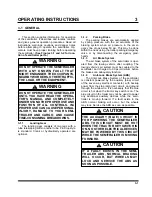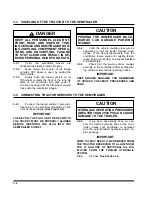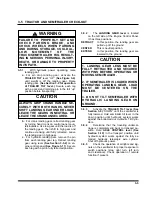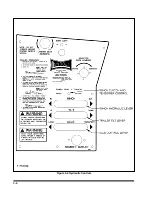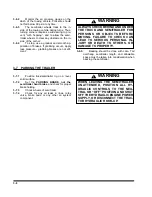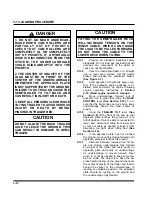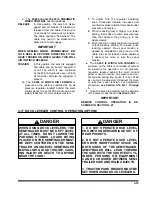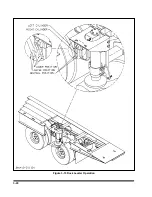
3-13 LOADING PROCEDURE
DANGER
1. DO NOT GO NEAR UNDERCAR-
RIAGE WHEN CAM ROLLERS ARE
PARTIALLY OUT OF POCKETS.
CHECK THAT CAM ROLLERS ARE
COMPLETELY IN, OR COMPLETELY
OUT OF POCKETS. IF A HYDRAULIC
HOSE IS DISCONNECTED FROM THE
SYSTEM, THE UNDERCARRIAGE
COULD SLIDE ABRUPTLY INTO THE
POCKETS.
2. THE CENTER OF GRAVITY OF THE
LOAD MUST BE IN FRONT OF THE
CENTER OF THE UNDERCARRIAGE
WHENEVER THE APPROACH PLATE
IS NOT SUPPORTED BY THE GROUND.
FAILURE TO DO THIS CAN CAUSE THE
SEMITRAILER TO TILT BACK AND
CAN RESULT IN INJURY OR DEATH.
3. KEEP ALL PERSONS CLEAR WHILE
TILTING TRAILER TO AVOID SERIOUS
INJURY OR DEATH BY BEING
PINCHED IN TRAILER BED.
CAUTION
DO NOT ALLOW THE BACK TRAILER
AXLE TO LEAVE THE GROUND. THIS
CAN RESULT IN DAMAGE TO SEMI-
TRAILER.
CAUTION
TILTING THE SEMITRAILER DECK
WILL INCREASE TENSION ON THE
WINCH CABLE, WHICH CAN CAUSE
THE LOAD TO BE PULLED FORWARD.
DO NOT HOOK THE CABLE TO THE
LOWER DECK WHEN TILTING.
3-13.1
Practice all standard industrial safety
standards. Do not load any payload that will
overload any component of the trailer or
cause an unsafe condition.
3-13.2
Park the tractor/semitrailer in a straight
line on level even surface. Set the tractor
brakes and release the semitrailer brakes
(See Figure 3-7).
3-13.3
Start operation of hydraulic power sys-
tem. If the hydraulic engine package is in-
stalled, start and warm up engine following
engine operating instructions in
Section
3-18. (Read engine operator’s manual.)
3-13.4
Move undercarriage forward (out of
pockets) five to eight feet using the
AXLE
CONTROL
lever
(See Section 3-10)
. To in-
sure that the trailer does not rock back, keep
undercarriage behind the trailer center of
gravity.
3-13.5
Using the
TRAILER TILT
lever
(See
Section 3-9)
tilt the front of the bed up until
approach plate touches the ground or is to
full tilt position. If winch cable is connected to
lower bed, disconnect cable from lower bed
or reel out cable as needed to keep it from
becoming too tight when tilting bed
(See
Section 3-16).
3-13.6
If the approach plate has not touched
the ground, move undercarriage forward until
approach plate just touches the ground.
3-13.7
Alternate between lowering bed tilt an-
gle and moving undercarriage fully forward
so weight of the trailer bed rests partly on
approach plate and partly on undercarriage
as undercarriage is moved forward. Reel
winch in or out as needed to keep some ten-
sion on cable. The object is to have the ap-
proach plate resting on the ground whenever
the center of gravity of the trailer and load is
behind the center of the undercarriage. In
loading or unloading position, the approach
plate should be resting on the ground and
the undercarriage fully forward.
3-12
Summary of Contents for 600B Series
Page 8: ......
Page 12: ......
Page 14: ...3 2 Figure 3 1 Front Trailer Terminology Figure 3 2 Rear Trailer Terminology...
Page 18: ...3 6 Figure 3 4 Hydraulic Controls...
Page 26: ...3 14 Figure 3 7 Steps for Loading and Unloading...
Page 32: ...3 20 Figure 3 10 Dock Leveler Operation...
Page 38: ...3 26 Figure 3 14 Rear Impact Guard and Antilock Brake System...
Page 42: ...4 2 Figure 4 1 Lubrication Points...
Page 48: ...4 8 Figure 4 3 600B Wiring Diagram...
Page 49: ...4 9 Figure 4 4 Remote Wiring Diagram...
Page 52: ...4 12 Figure 4 5 Tandem Axle Air Ride Suspension System Figure 4 6 Air Ride Height Adjustment...
Page 54: ...4 14 Figure 4 7 Triple Axle Air Ride Suspension System...
Page 57: ...4 17 Figure 4 9 Checking Axle Alignment Figure 4 10 Examples of Camber...
Page 61: ...4 21 Figure 4 13 Axle and Brake Assembly...
Page 71: ...4 31 Figure 4 21 Dock Leveler Leg Assembly...
Page 73: ...4 33 Figure 4 22 Crank Landing Gear Assembly...
Page 84: ...NOTES 5 10...




